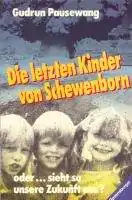The Last Children of Schewenborn
The Last Children of Schewenborn (German: Die letzten Kinder von Schewenborn) is a 1983 novel by Gudrun Pausewang, depicting life in rural Germany in the aftermath of a nuclear war.
 German edition cover | |
| Author | Gudrun Pausewang |
|---|---|
| Country | Germany |
| Language | German |
| Genre | Drama |
Publication date | 1983 |
| Media type | Print (Hardback and paperback) |
While the story is entirely fictional, Pausewang confirmed in the book's epilogue that she created its main setting, the small town of Schewenborn, in the image of Schlitz in East Hesse, where she herself used to live.
Plot summary
The plot is set within the framework of a Cold War scenario very similar to the geopolitical situation at the time of writing. It is told from the perspective of Roland, a 12-year-old boy from Bonames (a district of Frankfurt), who travels with his parents and sisters to visit his grandparents in Schewenborn.
During their journey, they are surprised by a nuclear attack. As emergency response systems fail to activate and no humanitarian aid reaches them, the survivors have to assume that the whole of Germany, or even the entire civilized world, may have been destroyed. The question of whether this is actually the truth is only resolved by the end of the novel.
The family finds refuge in the house of the grandparents, who were in Fulda at the time of the nuclear explosion and presumably died there. Shortly afterwards, Roland's mother takes in a young brother and sister who had been made orphans by the bombs.
The later chapters of the story describe the weeks, months and years after the nuclear attack, and are almost exclusively set in Schewenborn.
The Last Children of Schewenborn does not have a happy ending. One by one, members of Roland's family, including a new-born sibling without eyes, die of radiation sickness and other illnesses. By the end of the book, only Roland, his father, and a small group of boys and girls representing the titular last children remain alive, and the final paragraphs suggest that they, too, will perish.[1]
Major themes
The book is written as a cautionary tale in its clear intent to deliver a stern warning to both civilians and world leaders, similar to other dystopian literature.
It is aimed at a juvenile audience in particular, consequentially becoming part of recommended reading lists in several West German states, mostly directed at teenagers around the eighth grade.[2]
A similar theme, also specifically targeted at a younger audience, appears in Pausewang's other great literary success, Die Wolke. Both books convey a feeling of dark, impending danger commonly shared by members of the German Environmentalist Movement of the 1980s.
Awards and nominations
- Buxtehuder Bulle, 1983
- Zürcher Kinderbuchpreis (Zürich children's literature prize)
- Preis der Leseratten
- Gustav-Heinemann-Friedenspreis (Gustav Heinemann peace prize)
References
- Pausewang, Gudrun (1983). The Last Children of Schewenborn. Ravensburger. ISBN 978-3473580071.
- Liere, Judith (27 February 2014). "Die letzten Kinder von Schewenborn: Horror-Schocker-Kinderliteratur" (in German). Der Spiegel. Retrieved 24 January 2020.